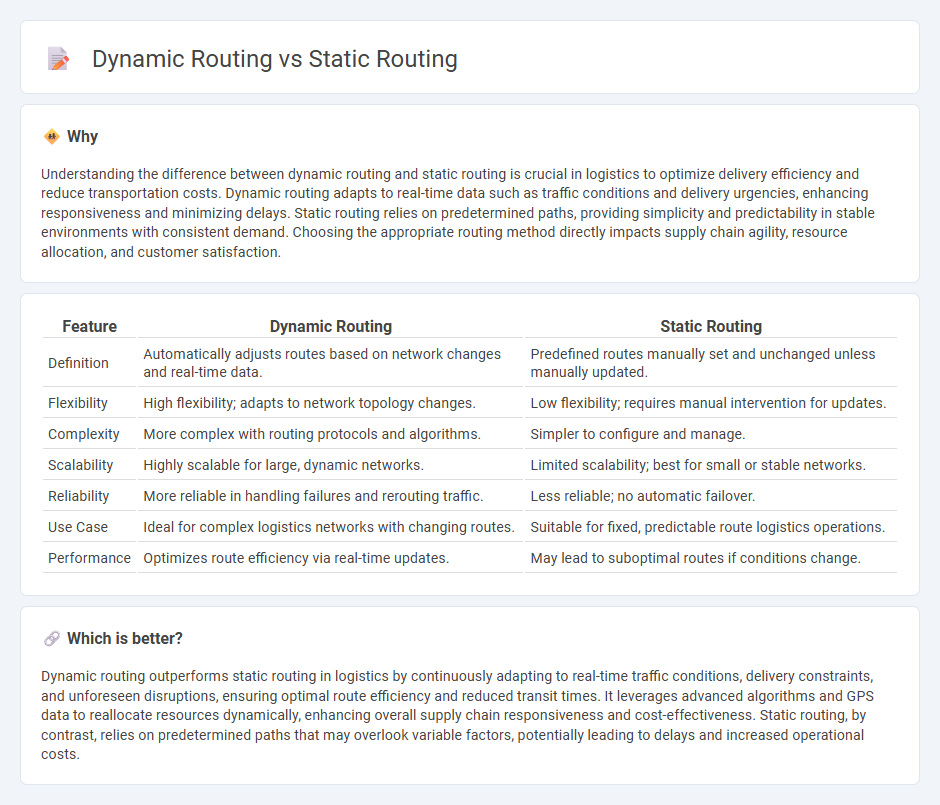
Dynamic routing adapts in real-time to changing traffic conditions, optimizing delivery routes based on current data such as traffic congestion, road closures, and weather patterns, which reduces transit times and fuel consumption. Static routing follows predetermined paths regardless of external factors, often resulting in less efficient deliveries and higher operational costs. Explore how dynamic routing innovations can significantly enhance logistics efficiency and cost-effectiveness.
Why it is important
Understanding the difference between dynamic routing and static routing is crucial in logistics to optimize delivery efficiency and reduce transportation costs. Dynamic routing adapts to real-time data such as traffic conditions and delivery urgencies, enhancing responsiveness and minimizing delays. Static routing relies on predetermined paths, providing simplicity and predictability in stable environments with consistent demand. Choosing the appropriate routing method directly impacts supply chain agility, resource allocation, and customer satisfaction.
Comparison Table
| Feature | Dynamic Routing | Static Routing |
|---|---|---|
| Definition | Automatically adjusts routes based on network changes and real-time data. | Predefined routes manually set and unchanged unless manually updated. |
| Flexibility | High flexibility; adapts to network topology changes. | Low flexibility; requires manual intervention for updates. |
| Complexity | More complex with routing protocols and algorithms. | Simpler to configure and manage. |
| Scalability | Highly scalable for large, dynamic networks. | Limited scalability; best for small or stable networks. |
| Reliability | More reliable in handling failures and rerouting traffic. | Less reliable; no automatic failover. |
| Use Case | Ideal for complex logistics networks with changing routes. | Suitable for fixed, predictable route logistics operations. |
| Performance | Optimizes route efficiency via real-time updates. | May lead to suboptimal routes if conditions change. |
Which is better?
Dynamic routing outperforms static routing in logistics by continuously adapting to real-time traffic conditions, delivery constraints, and unforeseen disruptions, ensuring optimal route efficiency and reduced transit times. It leverages advanced algorithms and GPS data to reallocate resources dynamically, enhancing overall supply chain responsiveness and cost-effectiveness. Static routing, by contrast, relies on predetermined paths that may overlook variable factors, potentially leading to delays and increased operational costs.
Connection
Dynamic routing and static routing are connected through their roles in network traffic management within logistics systems. Static routing involves predetermined paths configured by network administrators, ensuring reliable and predictable data flow for supply chain operations, while dynamic routing uses algorithms to automatically adjust paths based on real-time network conditions, enhancing responsiveness and efficiency. Integrating both routing methods optimizes route selection, balances network load, and improves the performance of logistics communication networks.
Key Terms
Routing Table
Static routing relies on manually configured entries in the routing table, ensuring predictable paths and minimal CPU overhead but requiring extensive administrative effort for updates. Dynamic routing protocols like OSPF or RIP automatically adjust routing tables based on network topology changes, enhancing scalability and fault tolerance. Explore the detailed differences in routing table management to optimize network performance and reliability.
Protocols
Static routing relies on manually configured routes using protocols like the Routing Information Protocol (RIP) for small networks, whereas dynamic routing employs protocols such as Open Shortest Path First (OSPF), Border Gateway Protocol (BGP), and Enhanced Interior Gateway Routing Protocol (EIGRP) to automatically adjust paths based on network topology changes. Static routing offers simplicity and low overhead but lacks scalability and adaptability compared to dynamic routing protocols, which provide efficient path determination and fault tolerance. Explore further to understand how specific routing protocols optimize network performance for varied environments.
Network Topology
Static routing requires manual configuration of routes, making it suitable for simple or stable network topologies with minimal changes over time. Dynamic routing protocols, such as OSPF or EIGRP, automatically adjust to network topology changes, optimizing path selection and enhancing scalability for complex or frequently changing environments. Explore in-depth comparisons and use cases to select the best routing strategy for your network topology.
Source and External Links
Static routing - Wikipedia - Static routing is a method where routes are manually configured with fixed values that do not change unless manually edited, typically including a destination and gateway, and often used alongside dynamic routing protocols.
What is Static Routing? - CBT Nuggets - Static routing involves manually configured routes that direct traffic based on fixed paths, preferred for simplicity and predictability but limited in scalability and flexibility compared to dynamic routing.
Static routing | CCNA Blog - Static routes are used to communicate with remote networks, often supplemented by a default route that handles all unmatched traffic, typically important for edge routers connecting to ISPs or stub routers.
 dowidth.com
dowidth.com